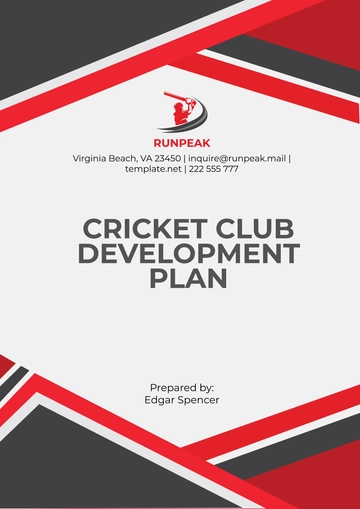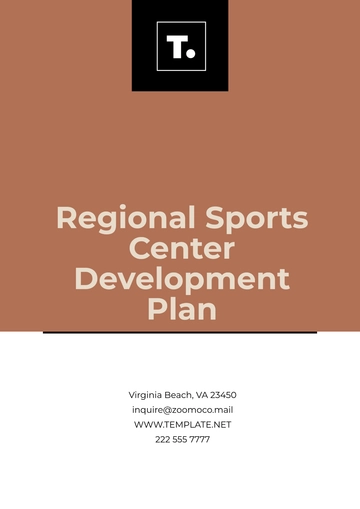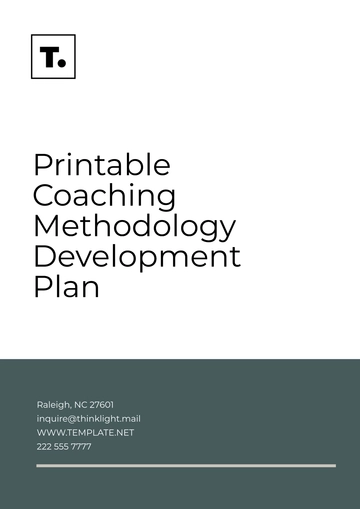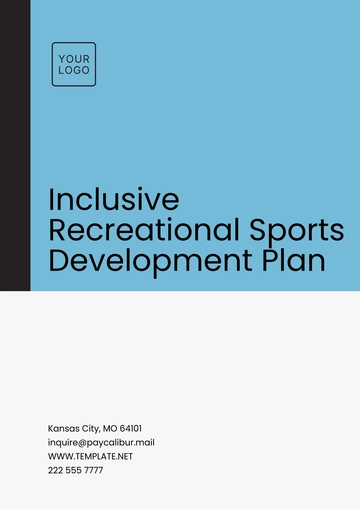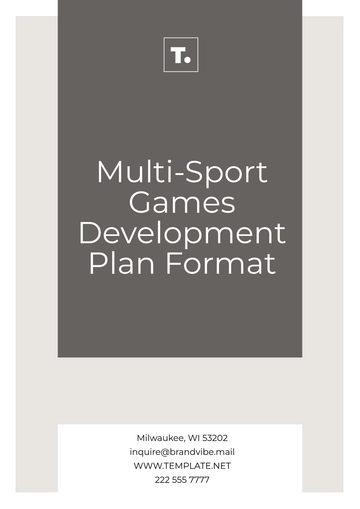Free Inclusive Recreational Sports Development Plan

Prepared by: [Your Name]
Date: July 12, 2050
1. Executive Summary
The Inclusive Recreational Sports Development Plan is a forward-thinking initiative aimed at enhancing access to recreational sports for all community members, with a focus on inclusivity, diversity, and equity. By addressing barriers to participation and fostering an environment of belonging, the plan seeks to improve community health, strengthen social bonds, and enhance individual well-being. Through strategic investments in facilities, programs, and community outreach, we aim to make recreational sports a vehicle for health equity, cultural integration, and community resilience.
2. Needs Assessment
2.1 Community Analysis
A comprehensive analysis of community demographics and needs is essential for creating a truly inclusive sports environment. Key steps include:
Participation Metrics: Gather data on current participation rates to identify underserved populations.
Accessibility Gaps: Audit sports facilities and programs to pinpoint physical, cultural, and financial barriers.
Community Input: Engage residents through surveys, focus groups, and town halls to gather direct feedback on needs and expectations.
2.2 Barriers to Participation
Participation in recreational sports is hindered by several challenges, including:
Physical Accessibility: Lack of ramps, adaptive equipment, and sensory-friendly environments.
Cultural Barriers: Limited representation of diverse traditions and activities.
Financial Constraints: High costs of equipment, program fees, and transportation.
Awareness Issues: Limited outreach and promotion to underrepresented groups.
Addressing these barriers through targeted interventions is central to the success of the plan.
3. Strategic Vision and Goals
3.1 Vision Statement
To establish a welcoming, equitable, and inclusive recreational sports environment that empowers all community members to engage, thrive, and connect through sports.
3.2 Key Goals
Enhance Accessibility: Upgrade facilities and programs to ensure full physical and sensory access.
Promote Diversity and Inclusion: Implement policies and practices that celebrate cultural and demographic diversity.
Increase Awareness: Improve outreach to underrepresented groups through tailored communication strategies.
Build Partnerships: Collaborate with stakeholders to leverage resources, expertise, and funding.
Embed Evaluation: Develop robust monitoring systems to track progress and inform continuous improvement.
4. Implementation Strategy
4.1 Facility Enhancement
Invest in accessible infrastructure to ensure equitable use of recreational sports facilities.
Facility Aspect | Improvement Action | Timeline |
|---|---|---|
Building Access | Install ramps and automatic doors | 6 months |
Equipment | Purchase adaptive sporting equipment | 3 months |
Signage | Implement multilingual and braille signage | 4 months |
4.2 Program Development
Develop programs tailored to diverse community segments:
Age-Specific Programs: Create offerings for children, youth, adults, and seniors.
Adaptive Sports: Introduce initiatives like wheelchair basketball, blind soccer, and sensory-friendly yoga.
Introductory Workshops: Provide free sessions to familiarize participants with various sports.
Cultural Sports Initiatives: Incorporate traditional and international sports to celebrate diversity.
4.3 Community Engagement
Inclusive Sports Events: Host accessible tournaments and open days to showcase inclusivity.
Outreach Campaigns: Use social media, local media, and community networks to promote programs.
Volunteer Mobilization: Engage community members as ambassadors and facilitators for programs.
4.4 Technology Integration
Leverage technology to improve accessibility and engagement:
Develop a mobile app or website to provide real-time updates on events, facilities, and programs.
Use virtual reality (VR) or augmented reality (AR) to train and familiarize participants with facilities and sports.
5. Evaluation and Monitoring
5.1 Performance Indicators
Set clear metrics to evaluate success:
Participation Rates: Track demographic representation in programs and events.
Accessibility Improvements: Measure the completion of facility upgrades against the plan.
Community Feedback: Collect and analyze participant satisfaction surveys.
5.2 Feedback and Continuous Improvement
Establish a feedback loop:
Conduct quarterly community focus groups and surveys.
Form an advisory board including diverse community representatives to guide initiatives.
6. Budget and Funding
6.1 Financial Plan
Category | Estimated Cost | Funding Source |
|---|---|---|
Facility Upgrades | $200,000 | Government grants, private donations |
Program Development | $100,000 | Local sponsorships, fundraising events |
Community Engagement | $50,000 | Non-profit partnerships, local businesses |
6.2 Funding Opportunities
Government Support: Apply for local and national grants promoting inclusivity.
Corporate Sponsorships: Partner with businesses committed to social responsibility.
Crowdfunding: Launch community-driven campaigns to raise awareness and funds.
Non-Profit Collaboration: Work with organizations focusing on sports and accessibility.
7. Risk Management
7.1 Potential Risks
Funding Shortfalls: Mitigate by diversifying funding sources.
Low Community Engagement: Address through tailored outreach strategies.
Implementation Delays: Set clear timelines and accountability measures.
7.2 Mitigation Strategies
Create contingency plans for critical tasks.
Regularly communicate progress with stakeholders to maintain support and transparency.
8. Conclusion
The Inclusive Recreational Sports Development Plan offers a roadmap to transforming recreational sports into a platform for equity, integration, and well-being. By addressing barriers, fostering collaboration, and embedding inclusivity into all aspects of planning, the initiative will serve as a cornerstone for building stronger, healthier, and more united communities.
- 100% Customizable, free editor
- Access 1 Million+ Templates, photo’s & graphics
- Download or share as a template
- Click and replace photos, graphics, text, backgrounds
- Resize, crop, AI write & more
- Access advanced editor
Create a winning strategy with the Inclusive Recreational Sports Development Plan Template from Template.net. This fully customizable and editable template is designed to suit your specific needs. Editable in our AI Editor Tool, it ensures a seamless, user-friendly experience for tailoring plans that promote inclusive sports for everyone. Achieve your goals effortlessly with Template.net!





